Sun
in Hydrogen Alpha
With
Coronado PST
Uploaded
7/17/11

|
The sun had
a great many features today, and the seeing was fairly decent
so I was able to use the 5x barlow again to gain some details.
Clouds interfered with the first few frames, and the latest version
of Registax 6 has more problems dealing with moving dark vapors
moving over the sun than version 4. Once the clouds cleared (for
a short while) I was able to use the much superior version 6
for full disk registrations. One of the sunspots has a nice flare
on it too, appearing as a very brilliant white burned out region.
Also, a very nice flame shaped prom was on one edge and had plenty
of internal details as well.
Processing: For
the most part, two images of each field were taken, one normal
exposure and the second over exposed to show the very dim prominences.
These were combined if the edge of the sun was present most of
the time to show the full compliment of features. As is usual,
no prime focus images are possible with the PST since the back
focus is not sufficient.
|
Images
with the Coronado 2x barlow:
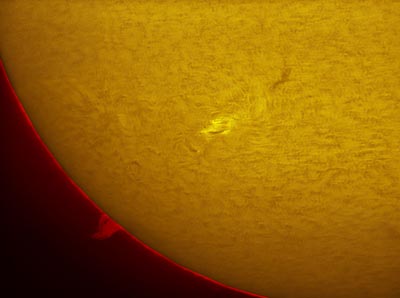 Select an image size for a larger view:
1290 x 960
Select an image size for a larger view:
1290 x 960
|
The big flame like
prom is seen off to the left, and on the disk is an active region
around a very tiny sunspot. The dark smudges around the spot
are called filaments, and are proms seen in silhouette against
the suns disk.
This image had
some cloud issues!
|
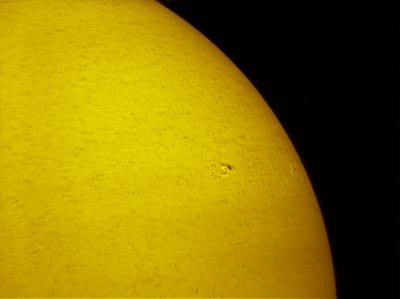 Select an image size for a larger view:
1290 x 960
Select an image size for a larger view:
1290 x 960
|
Now here is a white
light image taken on the other side of the sun. To do a white
light image with the PST, you crank the band pass adjust all
the way to the end and get basically a view in red light with
no hydrogen alpha features just like a white light view. compare
this image with the one below!
A single small
sunspot is seen here, with some faculae (white areas in the photosphere)
|
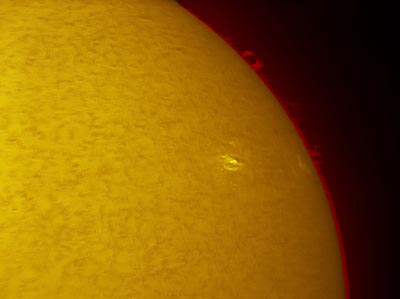 Select an image size for a larger view:
1290 x 960
Select an image size for a larger view:
1290 x 960
|
Now
here is the view in hydrogen alpha light. The details on the
sun are quite a bit more interesting. The white faculae are much
more prominent in this wavelength. The disk is covered with granulation.
Remember - you are no longer looking at the photosphere of the
sun. This is the basal Chromosphere, and the granulation is much
larger to see. The proms on the edge and the fuzz all around
the edge of the sun (spicules) are in the mid chromosphere. You
cannot image the outer photosphere from earths surface unless
there is a total eclipse. |
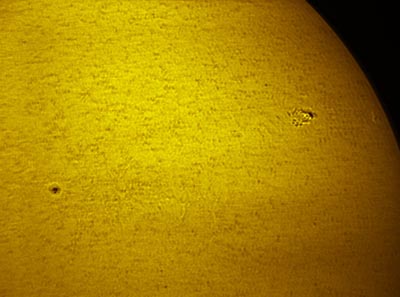 Select an image size for a larger view:
1290 x 960
Select an image size for a larger view:
1290 x 960
|
Moving
the sun to the right we can see another spot here in white light
coming on to the disk on the left. A bit of cloud is on the right
side. (darn monsoon!) |
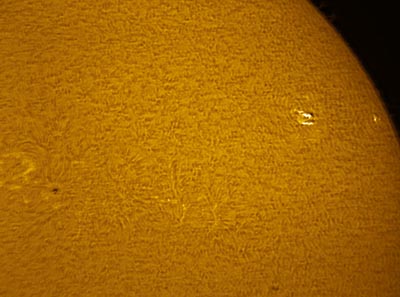 Select an image size for a larger view:
1290 x 960
Select an image size for a larger view:
1290 x 960
|
Here
the same view as above in H-Alpha light. We can now see a bit
of faculae around the spot on the left, but look in between the
two spots - some nice filaments are starting to show up. The
clouds went away at this point, and this image and those that
follow will have much better overall disk registration since
I used version 6. Look how nicely the program was able to register
even the granulation automatically. NONE of the older versions
did very well for me on this. |
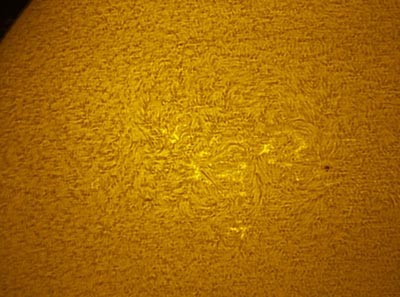 Select an image size for a larger view:
1290 x 960
Select an image size for a larger view:
1290 x 960
|
The
sunspot that was on the left in the above image is now on the
right. There is some amazing activity going on disturbing the
magnetic fields of the granulation here. I will have a 5x close
up below. |
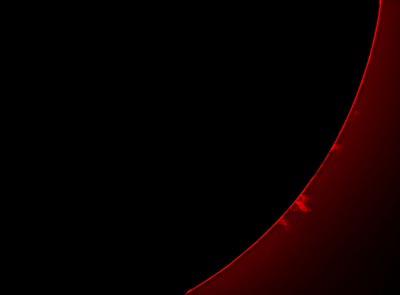 Select an image size for a larger view:
1290 x 960
Select an image size for a larger view:
1290 x 960
|
The
lower right side of the Sun had some significant but small prom
details. I was not able to get a clear shot of the disk due to
clouds, so I darkened out the disk which is quite overexposed
to show only the spicules fringe, and the proms. Believe me,
if you don't do this the blasted solar disk really takes away
from the faint prominences! |
Images
with the Televue 5x powermate barlow:
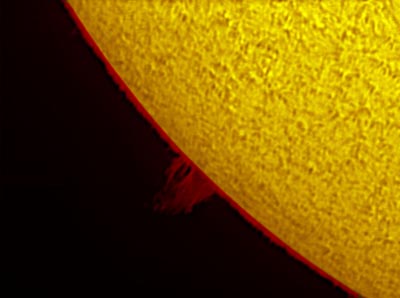 Select an image size for a larger view:
1290 x 960
Select an image size for a larger view:
1290 x 960
|
Now
were talking more details. The flame like big prom on the edge
was stunning to say the least at 5x. This is a single frame,
the prom was so bright I did not have to stack in the over exposed
background. I did however continue the standard "tradition"
of coloring the spicules and proms their correct blood red color. |
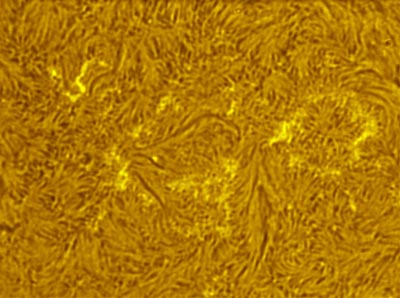 Select an image size for a larger view:
1290 x 960
Select an image size for a larger view:
1290 x 960
|
The
active region imaged above on the center of the disk is quite
nicely detailed at 5x. Seeing was starting to degrade a bit,
but this shot still shows far more resolution than the 2x barlow.
What an amazing tortured region on the sun... |
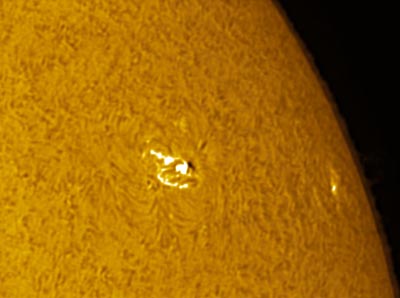 Select an image size for a larger view:
1290 x 960
Select an image size for a larger view:
1290 x 960
|
The sunspot on
the right edge on closer examination was flaring. It is only
a small B class flare, nothing to get excited about as far as
aurora, but it was so brilliant that the area burned in pure
white. An hour later, it was gone. Wow.
Look at the lumpy
texture to the spicules on the edge here too.
|
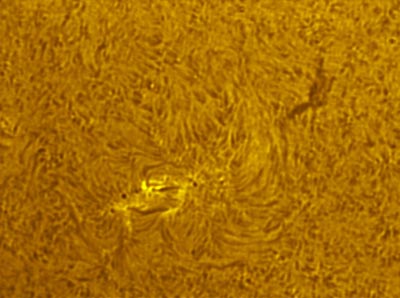 Select an image size for a larger view:
1290 x 960
Select an image size for a larger view:
1290 x 960
|
The
other sunspot with the attending filament looks quite a bit more
detailed here, You can imagine the twisting field lines of the
sun spot which are seen very well in H alpha. |
I
hope you enjoyed this small presentation. I had fun making this,
and am slowly creeping up the learning curve on this solar imaging
stuff. As I get better at it, Ill certainly share my results
with all of you as they come in...
 Instrument: Coronado PST 40mm
Platform: Astrophysics 1200
Camera: DMK 1024
Location: Payson, Arizona
Elevation: 5150 ft.
Sky: Seeing 6/10, Transparency 5/10
Outside Temperature: 80F
Processing: Registax 4 and 6, Photoshop CS
HOME SCHMIDT GALAXIES EMISSION NEBS REFLECTION NEBS COMETS
GLOBULARS OPEN CLUST PLANETARIES LINKS
Instrument: Coronado PST 40mm
Platform: Astrophysics 1200
Camera: DMK 1024
Location: Payson, Arizona
Elevation: 5150 ft.
Sky: Seeing 6/10, Transparency 5/10
Outside Temperature: 80F
Processing: Registax 4 and 6, Photoshop CS
HOME SCHMIDT GALAXIES EMISSION NEBS REFLECTION NEBS COMETS
GLOBULARS OPEN CLUST PLANETARIES LINKS
|
Instrument: Coronado PST 40mm Platform: Astrophysics 1200 Camera: DMK 1024 Location: Payson, Arizona Elevation: 5150 ft. Sky: Seeing 6/10, Transparency 5/10 Outside Temperature: 80F Processing: Registax 4 and 6, Photoshop CS HOME SCHMIDT GALAXIES EMISSION NEBS REFLECTION NEBS COMETS GLOBULARS OPEN CLUST PLANETARIES LINKS










